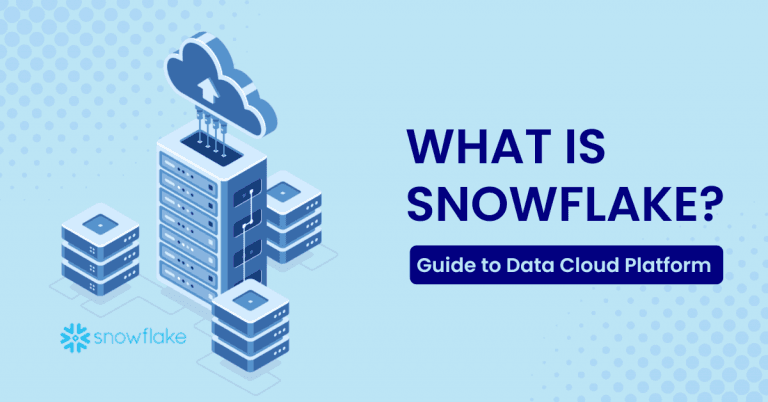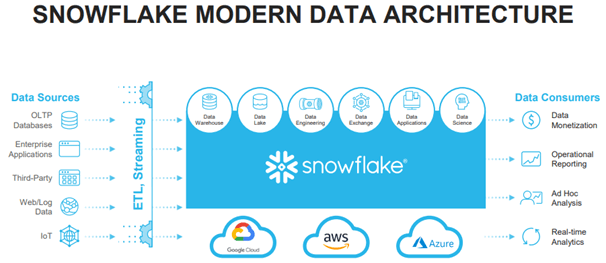P1]
In today’s data-driven world, businesses are constantly seeking ways to leverage their data to gain a competitive edge. This involves not just collecting vast amounts of information but also efficiently storing, processing, analyzing, and sharing it. Traditional data warehousing solutions often fall short, burdened by limitations in scalability, performance, and flexibility. Enter Snowflake, a cloud-based data platform designed to address these challenges and unlock the true potential of data.
Snowflake is not just another database; it’s a comprehensive Data Cloud, offering a unified platform for data warehousing, data lakes, data engineering, data science, data application development, and secure data sharing. Built on a fully relational ANSI SQL database engine, Snowflake leverages the power of the cloud to provide unparalleled scalability, performance, and ease of use, enabling organizations to derive insights and drive innovation faster than ever before.
Understanding Snowflake’s Architecture: The Key to its Power
At the heart of Snowflake’s success lies its unique and innovative architecture, which separates storage, compute, and cloud services. This separation allows each component to be scaled independently, providing unparalleled flexibility and efficiency.
Storage Layer: Snowflake utilizes cloud-based object storage, such as Amazon S3, Microsoft Azure Blob Storage, or Google Cloud Storage, to store all data. This layer is responsible for securely and reliably storing data in a compressed and optimized format. The separation of storage from compute means that storage costs are independent of processing needs. You only pay for the actual storage consumed, regardless of the computational power used for analysis.
Compute Layer: This layer comprises virtual warehouses, which are clusters of compute resources used to execute queries and perform data processing tasks. Virtual warehouses can be spun up and down on demand, allowing organizations to scale their computing power up or down based on their specific needs. This eliminates the need to provision and manage dedicated hardware, reducing costs and complexity. Snowflake offers a range of virtual warehouse sizes, from small to extra-large, allowing users to choose the optimal size for their workload.

Cloud Services Layer: This layer is the "brains" of the Snowflake system, responsible for managing and coordinating all activities within the platform. It handles tasks such as query optimization, metadata management, security, access control, and infrastructure management. This layer is fully managed by Snowflake, freeing users from the burden of managing the underlying infrastructure.

Key Features and Benefits of Snowflake:
Snowflake offers a wide range of features and benefits that make it a compelling choice for organizations of all sizes. Some of the most notable include:
Scalability and Elasticity: Snowflake’s architecture allows for seamless scaling of both storage and compute resources. Organizations can easily scale up their computing power to handle peak workloads and scale down when demand decreases, optimizing costs and performance. This elasticity is crucial for businesses experiencing rapid growth or fluctuating data volumes.

Performance: Snowflake’s optimized architecture and query processing engine deliver exceptional performance, enabling users to analyze large datasets quickly and efficiently. The ability to independently scale compute resources ensures that queries are executed in a timely manner, regardless of the data volume.
Concurrency: Snowflake supports high concurrency, allowing multiple users to access and query the data simultaneously without impacting performance. This is essential for organizations with large teams of analysts and data scientists who need to access the data concurrently.
Data Sharing: Snowflake’s secure data sharing capabilities allow organizations to easily share data with internal and external stakeholders without the need for data replication or complex ETL processes. This enables seamless collaboration and data monetization opportunities. Snowflake also offers data marketplace where users can discover and access third-party data sources.
Security: Snowflake prioritizes security, providing robust features to protect data at rest and in transit. This includes encryption, access control, network isolation, and compliance certifications. Snowflake is compliant with industry standards such as SOC 2 Type II, HIPAA, and PCI DSS.
Ease of Use: Snowflake’s user-friendly interface and intuitive SQL-based query language make it easy for users of all skill levels to access and analyze data. The platform also offers a range of tools and integrations to simplify data loading, transformation, and analysis.
Data Lake Support: Snowflake can seamlessly integrate with data lakes, allowing organizations to analyze both structured and semi-structured data in a unified platform. This enables users to gain insights from all their data, regardless of its format or location. Snowflake supports various data formats, including JSON, Avro, ORC, and Parquet.
Time Travel: Snowflake’s Time Travel feature allows users to access historical data from any point in time within a defined retention period. This is invaluable for auditing, data recovery, and analyzing trends over time.
Zero Management: Snowflake is a fully managed service, meaning that Snowflake handles all the underlying infrastructure and maintenance tasks. This frees users from the burden of managing servers, storage, and software updates, allowing them to focus on extracting value from their data.
Use Cases for Snowflake:
Snowflake’s versatility makes it suitable for a wide range of use cases across various industries. Some common examples include:
Data Warehousing: Consolidating data from various sources into a central repository for reporting, analysis, and decision-making. Snowflake’s scalability and performance make it ideal for handling large and complex data warehouses.
Business Intelligence (BI): Enabling users to create dashboards, reports, and visualizations to gain insights into business performance. Snowflake integrates seamlessly with popular BI tools such as Tableau, Power BI, and Looker.
Data Science: Providing a platform for data scientists to build and deploy machine learning models. Snowflake supports popular data science tools and frameworks such as Python, R, and Spark.
Data Engineering: Streamlining data pipelines and ETL processes to prepare data for analysis. Snowflake’s data integration capabilities and support for various data formats simplify data engineering tasks.
Data Lake Analytics: Analyzing data stored in data lakes to uncover hidden patterns and insights. Snowflake’s ability to handle both structured and semi-structured data makes it well-suited for data lake analytics.
Customer 360: Creating a unified view of the customer by integrating data from various sources such as CRM, marketing automation, and e-commerce systems. Snowflake enables organizations to gain a deeper understanding of their customers and personalize their experiences.
Fraud Detection: Analyzing transactional data to identify and prevent fraudulent activities. Snowflake’s performance and scalability allow for real-time fraud detection.
Supply Chain Optimization: Optimizing supply chain operations by analyzing data from various sources such as manufacturing, logistics, and inventory management systems. Snowflake enables organizations to improve efficiency and reduce costs throughout the supply chain.
The Future of Data: Snowflake and the Data Cloud
Snowflake is not just a data warehousing solution; it’s a platform that is shaping the future of data. As organizations continue to generate and collect vast amounts of data, the need for a scalable, performant, and flexible data platform will only continue to grow. Snowflake’s Data Cloud provides a unified platform for managing, analyzing, and sharing data, enabling organizations to unlock the full potential of their data and drive innovation.
Snowflake is continuously evolving, adding new features and capabilities to meet the evolving needs of its customers. The company is investing heavily in areas such as data governance, machine learning, and data application development. As Snowflake continues to innovate, it is poised to remain a leader in the data cloud space for years to come.
FAQ about Snowflake
Q: What is Snowflake?
A: Snowflake is a cloud-based data platform that provides data warehousing, data lakes, data engineering, data science, data application development, and secure data sharing capabilities. It’s built on a fully relational ANSI SQL database engine and leverages the power of the cloud to offer scalability, performance, and ease of use.
Q: What are the key benefits of using Snowflake?
A: Key benefits include:
- Scalability and Elasticity: Easily scale storage and compute resources as needed.
- Performance: Optimized architecture for fast query execution.
- Concurrency: Supports multiple users and queries simultaneously.
- Data Sharing: Securely share data with internal and external stakeholders.
- Security: Robust security features to protect data.
- Ease of Use: User-friendly interface and SQL-based query language.
- Data Lake Support: Integrates with data lakes for unified data analysis.
- Time Travel: Access historical data from any point in time.
- Zero Management: Fully managed service, eliminating infrastructure management.
Q: How does Snowflake’s architecture differ from traditional data warehouses?
A: Snowflake separates storage, compute, and cloud services. This allows each component to be scaled independently, unlike traditional data warehouses where storage and compute are tightly coupled.
Q: What cloud platforms does Snowflake support?
A: Snowflake supports Amazon Web Services (AWS), Microsoft Azure, and Google Cloud Platform (GCP).
Q: Is Snowflake expensive?
A: Snowflake’s pricing is based on consumption. You pay for the storage you use and the compute resources you consume. This pay-as-you-go model can be cost-effective, especially for organizations with fluctuating workloads. However, careful monitoring and optimization are crucial to manage costs effectively.
Q: What types of data can I store in Snowflake?
A: Snowflake supports structured, semi-structured, and unstructured data. It can handle data in various formats such as JSON, Avro, ORC, Parquet, CSV, and more.
Q: How secure is Snowflake?
A: Snowflake employs robust security measures, including encryption, access control, network isolation, and compliance certifications. It is compliant with industry standards such as SOC 2 Type II, HIPAA, and PCI DSS.
Q: Can I use Snowflake for real-time analytics?
A: While Snowflake is primarily designed for analytical workloads, it can be used for near real-time analytics with appropriate data ingestion and transformation strategies.
Q: What tools and technologies integrate with Snowflake?
A: Snowflake integrates with a wide range of tools and technologies, including BI tools (Tableau, Power BI, Looker), ETL tools (Informatica, Fivetran, Matillion), data science tools (Python, R, Spark), and more.
Q: How do I get started with Snowflake?
A: You can sign up for a free trial on the Snowflake website. Snowflake provides comprehensive documentation and tutorials to help you get started.
Conclusion
Snowflake has emerged as a game-changer in the data management landscape, offering a powerful and versatile platform for organizations seeking to unlock the true potential of their data. Its innovative architecture, comprehensive feature set, and ease of use make it a compelling alternative to traditional data warehousing solutions. By providing a unified platform for data warehousing, data lakes, data engineering, data science, and data sharing, Snowflake empowers organizations to derive insights, drive innovation, and gain a competitive edge in today’s data-driven world. As the data landscape continues to evolve, Snowflake is poised to remain at the forefront, shaping the future of data management and analytics. The Data Cloud is here, and Snowflake is leading the charge.


@lowres.png)
Leave a Reply